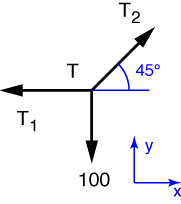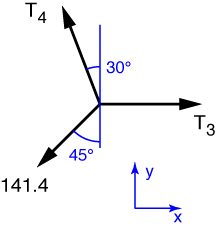Den Hartog’s Mechanics
A web-based solutions manual for statics and dynamics
Problem 9
This is a classic sort of problem, an academic exercise that isn’t really based on a real-world example. You’re likely to see problems like this in textbooks today.
We start with the point from which the 100 lb weight is hung. The free-body diagram of this point looks like this

The equilibrium equation for the y-direction is
from which we learn that T_2 = 141.4\:\rm{lb}. Using this result in the equilibrium equation in the x-direction
gives us T_1 = 100\:\rm{lb}.
We now move to the other point and draw the free-body-diagram

Equilibrium in the y-direction gives us the equation
from which we get T_4 = 200/\sqrt{3} = 115.5\:\rm{lb}. Using this in the equilbrium equation for the x-direction
gives us T_3 = 100/\sqrt{3} + 100 = 157.7\:\rm{lb}.
Last modified: January 22, 2009 at 8:32 PM.

